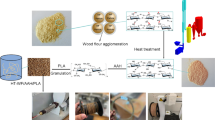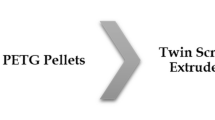Abstract
In the present study, investigations for mechanical, thermal and magnetic properties of polymeric composite matrix comprising of polylactic acid (PLA), polyvinyl chloride (PVC) reinforced with wood dust and magnetite (Fe3O4) powder have been reported for possible four-dimensional printing applications. PLA polymer shows 4D properties based upon external stimulus along with excellent mechanical properties. The reinforcement of PVC, wood dust and Fe3O4 in PLA affects the 4D capabilities of composite matrix, which has been explored in this work based upon coercivity, magnetization, retentivity along with tensile properties and thermal stability. It has been observed that mechanical processing with twin screw extrusion at 170 °C barrel temperature, 0.10 Nm torque and 10 kg load are the optimized parametric conditions for hybrid blend (composite composition/proportion PLA 50 wt%–PVC 25 wt%–Fe3O4 20 wt%–wood dust 5 wt%). Further, it has been ascertained that only screw temperature is significant parameter for controlling the mechanical properties of the extrudate. The results are supported by surface hardness, surface roughness (Ra), porosity percentage (%) and fractured surface analysis.











Similar content being viewed by others
References
Chacón JM, Caminero MA, García-Plaza E, Núñez PJ (2017) Additive manufacturing of PLA structures using fused deposition modeling: effect of process parameters on mechanical properties and their optimal selection. Mater Des 124:143–157. https://doi.org/10.1016/j.matdes.2017.03.065
Lanzotti A, Grasso M, Staiano G, Martorelli M (2015) The impact of process parameters on mechanical properties of parts fabricated in PLA with an open-source 3-D printer. Rapid Prototyp J 21(5):604–617. https://doi.org/10.1108/RPJ-09-2014-0135
Zhou Y, Lei L, Yang B, Li J, Ren J (2018) Preparation and characterization of polylactic acid (PLA) carbon nano-tube nano-composites. Polym Test 68:34–38. https://doi.org/10.1016/j.polymertesting.2018.03.044
Reinhardt M, Kaufmann J, Kausch M, Kroll L (2013) PLA-viscose-composites with continuous fibre reinforcement for structural applications. Proc Mater Sci 2:137–143. https://doi.org/10.1016/j.mspro.2013.02.016
Scaffaro R, Lopresti F, Botta L (2018) PLA based biocomposites reinforced with Posidonia oceanica leaves. Compos B Eng 139:1–11. https://doi.org/10.1016/j.compositesb.2017.11.048
Nasrin R, Biswas S, Rashid TU, Afrin S, Jahan RA, Haque P, Rahman MM (2017) Preparation of Chitin-PLA laminated composite for implantable application. Bioact Mater 2(4):199–207. https://doi.org/10.1016/j.bioactmat.2017.09.003
Bouakaz BS, Habi A, Grohens Y, Pillin I (2017) Organomontmorillonite/graphene-PLA/PCL nanofilled blends: new strategy to enhance the functional properties of PLA/PCL blend. Appl Clay Sci 139:81–91. https://doi.org/10.1016/j.clay.2017.01.014
Gupta MK, Singh R (2018) Flexural and dynamic mechanical analysis (DMA) of polylactic acid (PLA) coated sisal fibre reinforced polyester composite. Mater Today Proc 5(2):6109–6114. https://doi.org/10.1016/j.matpr.2017.12.216
Peponi L, Sessini V, Arrieta MP, Navarro-Baena I, Sonseca A, Dominici F, Kenny JM (2018) Thermally-activated shape memory effect on biodegradable nano-composites based on PLA/PCL blend reinforced with hydroxyapatite. Polym Degrad Stab 151:36–51. https://doi.org/10.1016/j.polymdegradstab.2018.02.019
Singla RK, Zafar MT, Maiti SN, Ghosh AK (2017) Physical blends of PLA with high vinyl acetate containing EVA and their rheological, thermo-mechanical and morphological responses. Polym Test 63:398–406. https://doi.org/10.1016/j.polymertesting.2017.08.042
Chen PY, Lian HY, Shih YF, Chen-Wei SM, Jeng RJ (2017) Preparation, characterization and crystallization kinetics of Kenaf fiber/multi-walled carbon nanotube/polylactic acid (PLA) green composites. Mater Chem Phys 196:249–255. https://doi.org/10.1016/j.matchemphys.2017.05.006
Wang Z, Xu Z, Lu Y, Hu L, Fan Y, Ma J, Zhou X (2017) Preparation of 3D printable micro/nanocellulose-polylactic acid (MNC/PLA) composite wire rods with high MNC constitution. Ind Crops Prod 109:889–896. https://doi.org/10.1016/j.indcrop.2017.09.061
Varsavas SD, Kaynak C (2018) Effects of glass fiber reinforcement and thermoplastic elastomer blending on the mechanical performance of polylactide. Compos Commun 8:24–30. https://doi.org/10.1016/j.coco.2018.03.003
Rahman MM, Islam MS, Li GS (2018) Development of PLA/CS/ZnO nano-composites and optimization it’s mechanical, thermal and water absorption properties. Polym Test 68:302–308. https://doi.org/10.1016/j.polymertesting.2018.04.026
Oksman K, Skrifvars M, Selin JF (2003) Natural fibres as reinforcement in polylactic acid (PLA) composites. Compos Sci Technol 63(9):1317–1324. https://doi.org/10.1016/S0266-3538(03)00103-9
Kelnar I, Kratochvíl J, Kaprálková L, Zhigunov A, Nevoralová M (2017) Graphite nano-platelets-modified PLA/PCL: effect of blend ratio and nano-filler localization on structure and properties. J Mech Behav Biomed Mater 71:271–278. https://doi.org/10.1016/j.jmbbm.2017.03.028
Leist SK, Gao D, Chiou R, Zhou J (2017) Investigating the shape memory properties of 4D printed polylactic acid (PLA) and the concept of 4D printing onto nylon fabrics for the creation of smart textiles. Virtual Phys Prototyp 12(4):290–300. https://doi.org/10.1080/17452759.2017.1341815
Abbas IA, Youssef HM (2009) Finite element analysis of two-temperature generalized magneto-thermoelasticity. Arch Appl Mech 79(10):917–925
Abbas IA, Abo-Dahab SM (2014) On the numerical solution of thermal shock problem for generalized magneto-thermoelasticity for an infinitely long annular cylinder with variable thermal conductivity. J Comput Theor Nanosci 11(3):607–618
Abbas IA, Youssef HM (2012) A nonlinear generalized thermoelasticity model of temperature-dependent materials using finite element method. Int J Thermophys 33(7):1302–1313
Abbas IA, Youssef HM (2013) Two-temperature generalized thermoelasticity under ramp-type heating by finite element method. Meccanica 48(2):331–339
Abd-Alla AENN, Abbas I (2002) A problem of generalized magnetothermoelasticity for an infinitely long, perfectly conducting cylinder. J Therm Stresses 25(11):1009–1025
Kumar R, Abbas IA (2013) Deformation due to thermal source in micropolar thermoelastic media with thermal and conductive temperatures. J Comput Theor Nanosci 10(9):2241–2247
Martin O, Avérous L (2001) Poly(lactic acid): plasticization and properties of biodegradable multiphase systems. Polymer 42(14):6209–6219. https://doi.org/10.1016/S0032-3861(01)00086-6
Jing X, Mi HY, Peng XF, Turng LS (2014) The morphology, properties, and shape memory behavior of polylactic acid/thermoplastic polyurethane blends. Polym Eng Sci 55(1):70–80. https://doi.org/10.1002/pen.23873
Zabłocka-Malicka M, Rutkowski P, Szczepaniak W (2015) Recovery of copper from PVC multiwire cable waste by steam gasification. Waste Manag 46:488–496. https://doi.org/10.1016/j.wasman.2015.08.001
Yang L, Hu Y, You F, Chen Z (2007) A novel method to prepare zinc hydroxystannate-coated inorganic fillers and its effect on the fire properties of PVC cable materials. Polym Eng Sci 47(7):1163–1169. https://doi.org/10.1002/pen.20482
Shiroishi H, Oda T, Hamada I, Fujima N (2003) Structure and magnetism on iron oxide clusters FenOm (n = 1–5): calculation from first principles. Eur Phys J D Atomic Mol Opt Phys 24(1–3):85–88. https://doi.org/10.1140/epjd/e2003-00136-3
Cornell RM, Schwertmann U (2003) The iron oxides: structure, properties, reactions, occurrences and uses, 2nd edn. Wiley, Weinheim
Yu B, Wang M, Sun H, Zhu F, Han J, Bhat G (2007) Preparation and properties of poly(lactic acid)/magnetic Fe3O4 composites and nonwovens. RSC Adv 7(66):41929–41935. https://doi.org/10.1039/C7RA06427F
Acknowledgement
The authors are thankful to GNDEC Ludhiana and TIET Patiala for providing laboratory facilities and continuous support in all form.
Author information
Authors and Affiliations
Corresponding author
Additional information
Technical Editor: Adriano Fagali de Souza.
Publisher's Note
Springer Nature remains neutral with regard to jurisdictional claims in published maps and institutional affiliations.
Rights and permissions
About this article
Cite this article
Kumar, S., Singh, R., Singh, T.P. et al. Investigations for mechanical, thermal and magnetic properties of polymeric composite matrix for four-dimensional printing applications. J Braz. Soc. Mech. Sci. Eng. 42, 160 (2020). https://doi.org/10.1007/s40430-020-2251-4
Received:
Accepted:
Published:
DOI: https://doi.org/10.1007/s40430-020-2251-4




